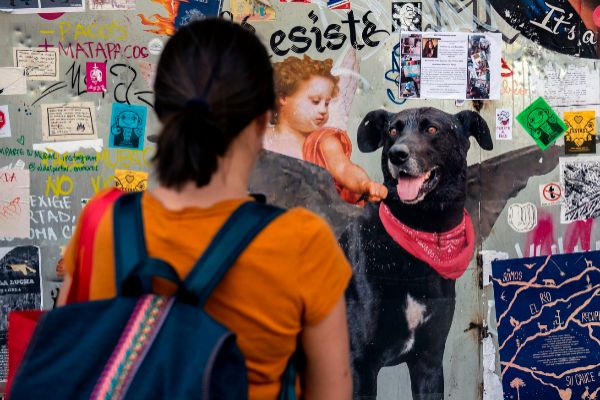- Social explosion Chile, closer and closer to deciding whether to bury the Constitution of Augusto Pinochet
- Questions with answers: The keys to violence in Chile, from idyllic economy to vulnerable society
The social movement that broke out in Chile in October was born without leaders or political color, but it does have an icon full of symbolism, the Negro Matapacos , a dog that these days poses in a thousand versions, even in murals that raise it to the angel of the Street.
The dog, without a breed but with an owner, died in 2017 and had already risen to fame in another wave of protests that shook power in 2011 , when university students claimed quality and freeness of expensive studies in Chile.
In those demonstrations, Negro Matapacos barked enraged every time he saw a policeman, pejoratively called pacos in Chile. He assumed an apparently protective posture of the students, staying by his side even when he was engulfed in a cloud of tear gas or soaked after the passage of the truck throws water.
For many it is the quiltro , as they call dogs without a breed in this country, which symbolizes the "Chile Awakened" movement born last October.
Although "the original Matapacos was not a street dog, he was empowered by the movement of the street by accompanying the students to the front line of battle," recalls Marcel Solá, the sculptor of a three-meter figure of this can revered by protesters Since last week he poses near Plaza de la Dignidad, as he baptized the movement to Plaza Italia, the historic center of popular celebrations in Santiago.
Canine archangel
Jet black, short and hard fur, sad reddish but intense look, long legs and tail. A picture that is repeated in murals of all kinds, surrounded by plump cherubs or celestial muses in the streets of Santiago, with slogans in favor of abortion, free education, better pensions and an equitable health system.
From 2009 until his death in 2017 the Negro Matapacos was in the care of Mrs. María Campos, near the University of Santiago (Usach). From there he followed the university students who put Sebastián Piñera's first Government (2010-2014) on the ropes in another wave of student protests.
The social outbreak that began in Chile on October 18, initially due to the rise in public transport, grew as a heterogeneous movement without voice, without platforms, without visible leader, and more than 60 days of protests can be said that the only iconography that unites them is the Negro Matapacos .
His figure stands out in T-shirts, scarves tied to the neck, canvases, murals, posters and key chains. The fame of this dog dates back to 2013, when a group of students from the University of Santo Tomás published a documentary called "Matapaco Documentary (2013)" on YouTube, in which schoolchildren in uniform report that the dog was only barking at the police.
Like a stray dog
In a Chile that debates in the streets the country that it desires with greater social well-being, a society that these days does not fit the motives of "conservatives" or "introverts", as defined by its Latin American neighbors, "a quiltro is the best emblem we can have, "Camila Silva, a 29-year-old girl from the Black Collective Skein, an embroidery group for dignity that was also born in the heat of the marches, told AFP.
This group of 10 young people embroidered for a week the red scarf for the sculpture of this black dog made of recycled materials from the waste of the massive marches in Santiago. The structure of the dog is made of iron from the bars destroyed in the city and papier-mâché, plated with sheets of metal .
"The quiltros of the street are abandoned, suffer abuse, segregation, somehow discrimination, abuse in different ways and worst of all, the indifference of many people," he explained to AFP Solá, architect of the project that turned Black Matapacos in a sculpture that was transferred to a square in a musical procession, full of young people, musicians, dancers, theater actors who raised the dog dodging the riots last Friday, on another very violent day.
Solá believes that it is "precisely that analogy that takes a large part of Chilean society, which gave itself to the front line of the people, is what this movement also symbolizes, the union, the delivery and goes beyond leadership of a person, "said the sculptor of a dog that today replaces statues of heroes.
According to the criteria of The Trust Project
Know more- Chile
Latin AmericaThe Chilean social movements call a new general strike for this Monday
ANNIVERSARY Bertín Osborne turns 65 but does not retire: he still has to settle debts with the Treasury
El Caminante The Centro Baños Árabes de Jaén hosts until the beginning of January the cultural and tourist program Winter Palace

